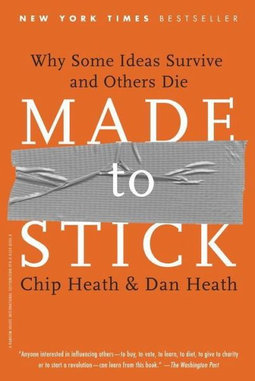When you write, write for your readers, they say. But will your readers remember? Will they even read the article to its end? Chip Heath and Dan Heath answer the question why some ideas survive and others die, i. e. why they are being remembered or forgotten.
This book gave me a different perspective on both writing and giving presentations. This write-up will help me remember the contents of the book and serve me as a check list before I present a talk or publish an article. I share it so you can find out if you want to read this book as well.
The Acronym to remember ¶
The Heath brothers form the acronym SUCCESs to capture the elements it needs for an idea to stick:
- Simple: a core that is easy to share
- Unexpected: to get and hold attention
- Concrete: to understand, remember and to allow coordination (if applicable)
- Credible: to help people believe
- Emotional: to make people care (either out of self-interest or group identity)
- Stories: to get people to act (as either simulation or inspiration)
And two things to remember:
Avoid the Curse Of Knowledge: If you describe what you know, you will never get the message across. Take the perspective of your earlier self and describe what changed for you.
Don’t bury the lead: don’t get lost in the sea of information. Pick one or two things and focus.
Credibility ¶
Adding Details to tip the Scales ¶
It surprised me when Chip and Dan describe that little, concrete details – even if they are meaningless to the core – increase the credibility of a story.
They describe an experiment with an (American) jury: From a transcript they should decide if a mother should keep the care for her child. The more vivid the details were (in this example “a Star Wars toothbrush that looks like Darth Vader”), the more the jury was in favour of the mother.
It is difficult for me to realise that this is how we behave as humans. Although the effect is small, it might be the one thing tipping the scales.
Making Statistics accessible ¶
Our brains have difficulties to tackle numbers, especially in statistics. It starts with 25% vs. a quarter vs. one in four people vs. three people of a soccer team.
The bigger or smaller the numbers are, the more difficult it gets for humans. The book contains great examples of accessible statistics.
Sinatra Test ¶
Frank Sinatra sings “If I can make it in there [New York], I can make it everywhere.” So what are the achievements of your product you are about to sell to your customer?
Testable Credentials ¶
If you are selling burgers, that is something everyone can test for herself or himself. But it also works for more intangible things like this example from Ronald Reagan’s presidential campaign: “[…] are you better off today than you were four years ago?”
The tangible things in IT are startup time, download size and render time of a JavaScript frameworks – developers can measure each of it themselves. With the intangible goods in IT consulting this will prove difficult for me, but I’ll give it a try next time.
Holding Attention ¶
When writing articles, there is the top-heavy triangle or the inverted pyramid: Keep the most important bits of the story at the top, as this keeps the reader going (and the reader might never read the end of the article).
But there’s something else: The knowledge gap or curiosity you keep from the beginning to the end. Not every article is a murder mystery, but maybe you can find something else to grab the reader’s attention? Hold on tight, the chapter most important to me is the next one!
Stories for the audience ¶
Spoiler alert: Chip and Dan found, that your readers will most likely only remember the vivid story you told them during your presentation, not the flat summary or essence you present at the end. Your story needs to be Simple, Unexpected, Concrete, Credible and Emotional. And it is the best weapon you have to fight the Curse Of Knowledge.
You’ll need to hunt down stories in real life to
- show a challenge including underdog and rag-to-riches (“David vs. Goliath”),
- present a connection to inspire in social ways (“Romeo and Juliet”),
- inspire creativity (“MacGyver”), or
- change the way people see a problem and switch them to problem-solving mode (“Springboard”).
Although this chapter is of the same length as all the other chapters, I feel that I have the most to gain from it (and to experiment with it).
Summary ¶
I enjoyed reading this book with all its examples. It is good to read, it is well structured and contains lots of examples. The “clinic” examples provide case studies with different texts covering the same issue and provide insights how you can achieve stickiness.
At the end of the book there’s a 5-page stickiness reference guide that summarises the chapters of the book. This together with the index helps you looking up advice from the book later in your day to day work.
Thank you to Wolfgang for pointing me at this book. This book is quite affordable: A used paperback is available for less than 10 USD, and about 8 EUR in Germany. It has its own homepage with an example chapter and more material to download including “6 Tips for Giving a Great Elevator Pitch” and “Teaching That Sticks”.
